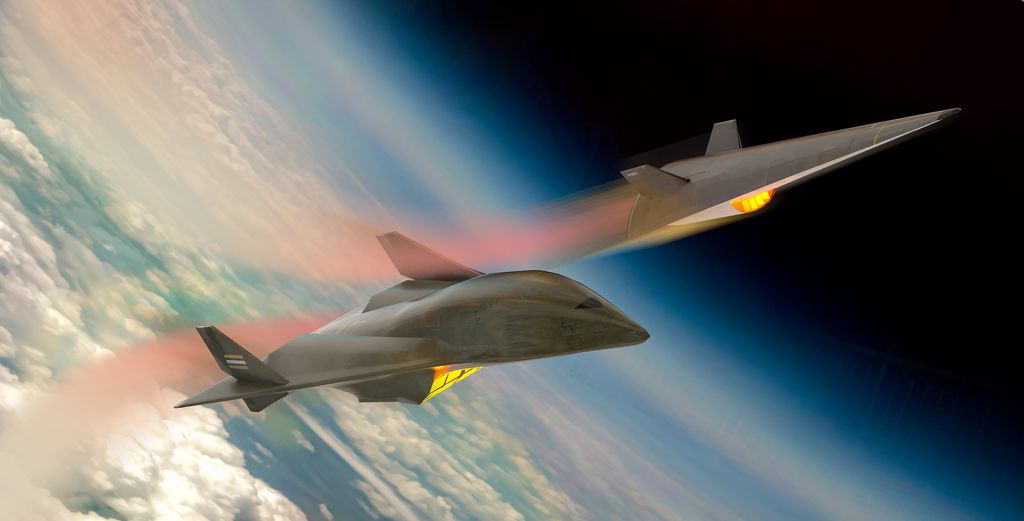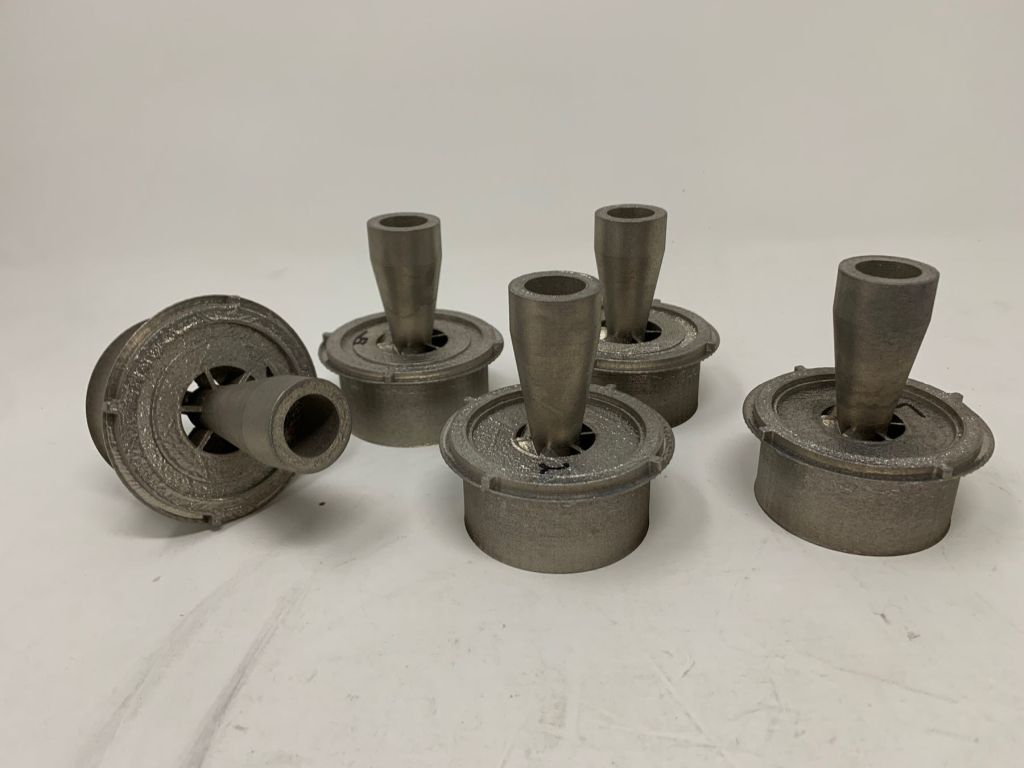3D-printed parts go hypersonic!

A team of researchers at Purdue University explain how they use Velo3D’s additive-manufactured injector components to create Mach 6 conditions for a ground-testing facility.
The term ‘hypersonics’ is getting renewed attention these days with the release of a US government report about unidentified aerial phenomena (UAPs) with ‘impossible’ flight behaviour—at speeds exceeding the critical Mach 5 level that defines the word. Whether you believe it’s extra-terrestrials, competitor nations, or domestic R&D (or maybe all of the above?!) behind the ongoing mystery, the lure of vehicles with unheard of speed and agility is compelling.
‘Supersonics’ denotes aircraft that break the sound barrier at Mach 1 (like the now-retired Concorde and the up-and-coming Boom Supersonic), and extends to around Mach 5, which is five times the speed of sound and more than 3,500mph at sea level. But very weird stuff starts happening as that upper speed is reached—you enter the hypersonics environment.
Exploring that unusual environment turns out to be a perfect proving ground for metal 3D printing, as researchers at Purdue University are learning. Their recent work is demonstrating that advanced additive manufacturing (AM) technology is now capable of producing fully dense, end-use parts with robustness that surpasses traditional methods like casting. Parts that can create hypersonic conditions and live to tell the tale.
“There’s a line you cross at around Mach 5,” begins Purdue Associate Professor, Carson Slabaugh, whose 20-person team at Zucrow Laboratories has been studying high-speed combustion systems since he started his lab at Purdue in 2015. “When a vehicle flies that fast, extreme compression and heating of the air flowing around and within the fuselage occurs. At Mach 5, it’s about a sixfold increase in the temperature and a pressure increase of a few hundred times. That kind of thermal and mechanical loading causes the regime of aerodynamics and thermodynamics and structural mechanics to completely change compared to lower-speed systems.”

According to Slabaugh, what this means is that, even just coming back through the atmosphere in response to gravity, “you’re traveling through a fireball at hypersonic speeds.” This happens when astronauts return to Earth from the International Space Station—and is why their modules are protected by massive heat shields. But if you want to achieve powered hypersonic flight—with a controllable aircraft, unmanned vehicle or missile—you need to add an engine, which is where it gets really intense.
Above Mach 5, the temperature of atmospheric air as it rushes by is thousands of degrees and the pressure is several hundred psi. The air itself can even become chemically reactive if you fly fast enough. These extreme flow conditions become a challenge to any vehicle-propulsion system whose thrust comes from burning fuel.
“If the incoming air is too hot, you really can’t add more useful energy to the flow by burning fuel. Dissociation effects become very strong and the reactions cannot proceed to completion,” says Slabaugh. “Cooling also becomes exceedingly difficult at these flight speeds.”
To avoid what rocket scientists jokingly call “unplanned rapid disassembly,” the team at Zucrow Labs is focused on learning everything possible about the critical turbulent (reacting) flow physics that must be accounted for when an engine reaches hypersonic speeds.
To meet this challenge, Slabaugh and his team partnered with Velo3D to ‘print’ fuel injectors with complex geometries that achieve very high fuel-air mixing performance. The parts could not have been made with conventional fabrication methods, especially not with the high-temperature, high-strength metal superalloys needed to survive the extreme testing conditions. The teams worked together to rapidly prototype the Purdue team’s designs for testing, evaluation, and design iteration. Slabaugh and team then used the data from the prototypes to scale up their designs into a full-scale system, which Velo3D also manufactured.
“Through our partnership, we helped Velo3D to understand the design requirements for high-speed combustion systems and they taught us how to better design for additive manufacturing,” states Slabaugh. “This is the sort of mutually beneficial relationship we build with industry partners as we solve the challenges associated with advanced technology transition.”
Why even high-speed computing can’t keep up
Because designing and manufacturing parts for hypersonic conditions—let alone attempting to fly vehicles going that fast—is understandably expensive, much of the R&D for developing hypersonic capabilities has been supported by NASA and defence-level budgets. Flight testing these systems is expensive, and has major limits on what can be actually measured for research purposes. Engineers lean heavily on earthbound solutions to develop new technologies while keeping costs in check. They are recreating the conditions experienced during hypersonic flight and proving-out engine components in ground-test facilities—like the one at Purdue for which Slabaugh’s team is building a rocket that will never leave Earth.
“We engineer components that will experience hypersonic environments while going zero miles per hour and staying bolted to the ground,” adds Slabaugh.

It’s even more difficult than it sounds—because this actually is rocket science. For some time now, advanced computer simulation software has been a valuable tool for engineers who need to explore the relationship between complex physics and physical structures. Methods like computational fluid dynamics (CFD) and fluid-structure interaction (FSI) can be used to simulate material and structural behaviour in response to the flow of air or liquid, allowing engineers to optimise their designs before ever manufacturing anything. But hypersonics turns out to be extremely unpredictable, defeating even the most sophisticated computer-simulation capabilities.
“One fundamental problem is that we can’t reliably predict the flow and flame conditions within the engine at hypersonic conditions,” explains Slabaugh. “Reacting, turbulent-flow is extremely complicated to model with CFD; we’re at such extreme levels of turbulence and flow conditions that we just can’t capture everything that happens as the flame evolves. Within the flow you have evolving density, viscosity, velocity, species, etc.—and when you add in mechanical structures like engine walls to contain the flame you get even more complicated with cooling designs that can also affect the flow and flame. The computational power you need to analyse even the smallest part of this engine is hugely expensive—and the end result is that many simplifying assumptions must be made for integrated design analysis.”
Evaluating these assumptions and their effect on model accuracy is a key theme of Slabaugh’s work.
3D printing delivers a faster solution for hypersonics-worthy parts
So how do you get engineers unstuck from this kind of problem? Leave simulation behind and go back to the real-world, classic, manufacturing paradigm of ‘build and break’ (or build and burn, in this case). With a twist this time: using advanced metal AM for the ‘build’ part of the equation.
“What we’re working on with Velo3D is basically a very large 3D-printed burner, which will be used to create the hypersonic flow environment on the ground in a test cell,” says Slabaugh. “Effectively, if you want to test a hypersonic vehicle on the ground you build a rocket engine with a big converging-diverging nozzle and a supersonic plume of extremely hot gas; the ‘fireball’ that the vehicle is flying through. The whole system is bolted down into lots and lots of concrete. You then stick whatever component you’re designing inside that plume and watch what happens.
“With Velo3D, we’re designing the injectors for that combustor to produce very specific turbulent flow fields that mix fuel at a certain rate and allow us to stabilise a very powerful flame in a very compact volume. This creates the conditions for all the things we’re going to test downstream.”
This is where AM is proving its worth for the ‘build and burn’. The ability to quickly 3D-print a variety of injector geometries for the test combustor—in this case made out of Hastelloy X, one of the few high-strength, high-temperature superalloys that can withstand the hypersonics environment—enabled the Purdue team to rapidly identify which design worked best.
For Nick Strahan, a test engineer working on Slabaugh’s team, the experience of using AM was an eye-opener.
“We had essentially approached this problem with traditional subtractive manufacturing techniques in mind before,” he says. “But there were some features in our design that would have limited the performance of the combustor—and doing it additively with Velo3D instead enabled us to integrate our unique geometry much more easily.”
Swerving past the roadblocks of traditional manufacturing
Using traditional subtractive manufacturing would have meant casting individual parts, which requires long, drawn-out cycles of tooling, mould-making, and design iteration.
“AM techniques significantly shortened manufacturing lead times as we optimised our designs,” states Strahan.
The engineers subtly varied the flow passages of the injector with five different designs (just a matter of tweaking the STEP data file that the Velo3D Sapphire system’s print-preparation software accommodated automatically), printed them out and ran them through a gauntlet of hypersonic-relevant test conditions.
“The Velo3D end-to-end manufacturing system produced dense parts requiring minimal post-processing,” says Strahan. “With just a little bit of clean-up machining, we could install them into our research-scale combustor for testing. We could then measure the combustion efficiency produced by each geometry with the goal of generating a flow that is chemically and thermodynamically similar to the atmosphere at very high flight speeds.”
In just two weeks the team was able to isolate the highest performer that had all the stationary and dynamic features they were looking for.
That high-performance injector met the critical parameters that the engineers valued most for performance of the combustor: flame power (as a proxy for the simulated flight conditions) and flame stability (a metric for the health and efficiency of the combustor).
“Both power and stability were necessary for us to create the realistic ground-test environment with our device, but these are often very difficult parameters to balance in a large-scale device,” notes Slabaugh. “We were able to tune the injector geometry and flow conditions independently in our testing to achieve optimum outcomes with these two, inseparable parameters. We see AM as a powerful tool with which we can bring other creative engineering solutions to complex design problems into reality more quickly.”
Accelerating towards the future
Now that the single injector design has passed rigorous testing, the aim is to assemble a large array of them into an even more powerful combustor. Velo3D is consulting further with Zucrow labs to help them take advantage of its build-anything-you-want capabilities—by integrating the injector set into a single piece, 3D-printed component. From there, the engineers will continue to refine and assemble a complete combustor system, aiming for full-scale hypersonic test capability in the fall of 2022.
The team at Zucrow labs anticipates that 3D printing will continue to be an important R&D, as well as production, technology for their work.
“Additive is really helpful in the research context where we are continually trying out different configurations of parts,” concludes Slabaugh. “At the same time, with this 3D-printed injector part, we couldn’t tell the difference between it and a machined part in many ways. Ten years ago, this technology seemed like a fantasy, but we are now getting AM parts that can go straight into our engines off of the printer—which is pretty amazing.”
“AM is an enabling technology for the combustion devices, thermal-management systems, and structural components across many of these disciplines, including hypersonics, and will no doubt prove to be especially valuable in this field, going forward.”












